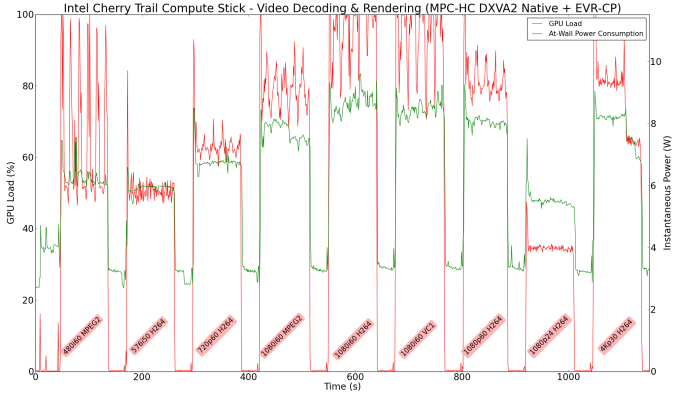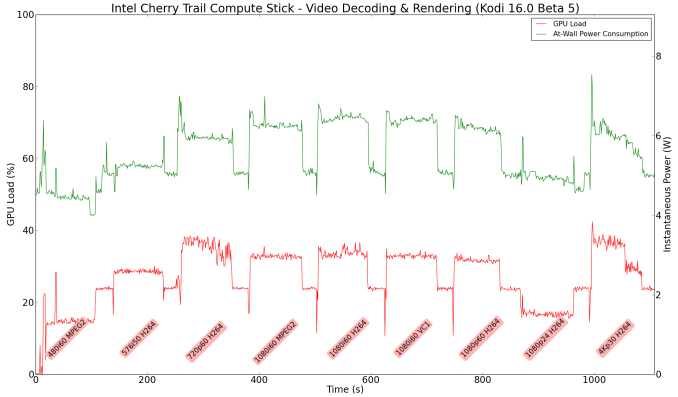The Intel Compute Stick (Cherry Trail) Review
by Ganesh T S on January 14, 2016 8:00 AM EST- Posted in
- Systems
- Intel
- Cherry Trail
- HDMI Stick
- CES 2016
- Compute Stick
HTPC Credentials
Usage of the Compute Stick as an entertainment platform is promoted by Intel as one of the use-cases. It is a bit surprising (given the form factor) that the Compute Stick has a fan. In this aspect, the Cherry Trail unit is no different from the Bay Trail unit. Subjectively, I was not comfortable with the acoustics in a 'office scenario' with the Compute Stick at the base of the monitor (connected via the HDMI extender cable) and myself seated around 70 cms. from it. The small diameter of the fan makes for a whining high-pitched noise, and it is compounded by the fact that it starts and stops depending on the SoC load.
Objectively speaking, Intel provided an acoustics rating of 28 dB at 1m distance for the noisiest mode. If the Compute Stick were to be hidden behind the TV, it is unlikely that users can hear such low noise at typical television viewing distances. It is not ideal, but Intel indicated that the performance of the device needs proper thermals. In order to to balance the very small size along with overall cost and performance, they decided to retain a small fan as the optimal thermal solution. Now that we have got the acoustics out of the way, let us move on to the other HTPC aspects.
Refresh Rate Accurancy
Starting with Haswell, Intel, AMD and NVIDIA have been on par with respect to display refresh rate accuracy. The most important refresh rate for videophiles is obviously 23.976 Hz (the 23 Hz setting). As expected, the Intel PPSTK1AW32SC has no trouble with refreshing the display appropriately in this setting. It actually performs better than the Bay Trail unit in this respect.
The gallery below presents some of the other refresh rates that we tested out. The first statistic in madVR's OSD indicates the display refresh rate.
Network Streaming Efficiency
Evaluation of OTT playback efficiency was done by playing back our standard YouTube test stream and five minutes from our standard Netflix test title. Using HTML5, the YouTube stream plays back a 720p encoding. Since YouTube now defaults to HTML5 for video playback, we have stopped evaluating Adobe Flash acceleration. Note that only NVIDIA exposes GPU and VPU loads separately. Both Intel and AMD bundle the decoder load along with the GPU load. The following two graphs show the power consumption at the wall for playback of the HTML5 stream in Mozilla Firefox (v 43.0.4).

GPU load was around 37.44% for the YouTube HTML5 stream and 11.14% for the steady state 6 Mbps Netflix streaming case.
Netflix streaming evaluation was done using the Windows 10 Netflix app. Manual stream selection is available (Ctrl-Alt-Shift-S) and debug information / statistics can also be viewed (Ctrl-Alt-Shift-D). Statistics collected for the YouTube streaming experiment were also collected here. While YouTube was more power efficient on the Cherry Trail Compute Stick, the Netflix case is the other way round. However, the numbers taken standalone do point to the Compute Stick units being a very power efficient platform for OTT streaming.

Decoding and Rendering Benchmarks
The form factor of the Compute Stick and the internal components make it clear that consumers are not going to play back videos using the madVR renderer. Instead, it is highly likely that Kodi will be used as the interface for media playback. We evaluated performance under MPC-HC + EVR-CP and Kodi 16.0 (Beta 5) for our test suite. Prior to those results, let us take a look at the codecs that are hardware-accelerated by the Cherry Trail SoC.
As expected, we have acceleration for MPEG-2, VC1, WMV9 and H.264. Interestingly, we also have support for HEVC (8-bit) and VP9 hardware-accelerated decoding in the upgraded GPU.
In our earlier reviews, we focused on presenting the GPU loading and power consumption at the wall in a table (with problematic streams in bold). Starting with the Broadwell NUC review, we decided to represent the GPU load and power consumption in a graph with dual Y-axes. Nine different test streams of 90 seconds each were played back with a gap of 30 seconds between each of them. The characteristics of each stream are annotated at the bottom of the graph. Note that the GPU usage is graphed in red and needs to be considered against the left axis, while the at-wall power consumption is graphed in green and needs to be considered against the right axis.
Frame drops are evident whenever the GPU load consistently stays above the 85 - 90% mark. In addition to tracking that aspect in the graphs below, we also get an idea of the system's power efficiency for decode and playback of some common codecs.
The above graph suggests that the Compute Stick is likely to drop frames when deinterlacing of high frame rate content is required. It is possible that EVR, the native renderer, will perform better than EVR-CP.
Kodi doesn't deinterlace content by default - so, the GPU load never goes unreasonably high. In the Bay Trail Compute Stick, Kodi struggled with the 1080i60 streams. Another aspect to observe with Kodi is that 'idling' at the XBMC interface consumes around 25% of the GPU resources and the power penalty is around 5 W. Depending on the codec and frame rate, the GPU load and power consumption might be lower or higher than the 'idle' state. For example, 480i60 and 1080p24 videos play back within the 5 W power envelop.
Note on HD Audio Bitstreaming
As of January 2016, the Intel graphics drivers for Cherry Trail (32-bit) have support only for bitstreaming of DTS, Dolby Digital and Dolby Digital Plus. This means that Netflix and other similar OTT sites are in the clear. However, users hoping to take advantage of lossless HD audio in Blu-ray backups are going to be disappointed. However, given the other limitations of the form factor and the system, it is unlikely that the absence of HD audio bitstreaming will bother too many consumers.




















80 Comments
View All Comments
074geodude - Monday, January 18, 2016 - link
Very technical review, but overall not very useful if you're a consumer. Things I would like to know that weren't answered in this review:- How long does it take to boot up?
- Can it stream 4K video?
- How's gaming performance? Are casual titles like Minecraft or League of Legends playable?
- How's web browsing with only 2 GB of RAM? How well does Chrome run?
- Can you clone the eMMC drive onto a microSD card and boot from that instead? (That way your external storage acts as your primary drive and you can have a 128 GB primary drive).
fackamato - Friday, January 22, 2016 - link
+1wyewye - Tuesday, January 19, 2016 - link
testtrivor - Tuesday, January 19, 2016 - link
Actually, I think micro PCs like the Dell 3050 or HP Stream are much better options. They have plenty of output options (4 or more USB ports, the Dell has a "real" M.2 SSD (user upgradeable up to a 2260 SSD - the 32 GB one is 2242), Gigabit Ethernet and 802.11AC WiFi, Celeron J1800). I think it will be fine as a media streamer with 13 GB left after installing the latest build of Windows 10. It may top out at 1080P but I think it's a couple of years before I'll worry about a 4K TV and 4K streaming. OBTW, I snagged the Micro 3050 over XMas @ $129. It also has both HDMI and Displayport and the RAM was easily accessible to upgrade to 8 GB for $30.ComputerExpertsCA - Thursday, January 21, 2016 - link
Why aren't there more ultra small PCs, tablets, and netbooks with 4GB of ram. Even smart phones have 4GB of ram. Do Microsoft's discounted OS license require a small amount of RAM?Teknobug - Tuesday, January 26, 2016 - link
Yes 2GB ram and 32GB storage is the point where Windows 10 is free and doesn't need a key.SilverBlade - Sunday, January 24, 2016 - link
No HD audio = not interested.Sorry...
floobit - Monday, January 25, 2016 - link
Ganesh or other staff writers - The W10 space restrictions seem to be an issue for all of these "limited devices". Presumably some thought from the Microsoft marketing dept has gone into the thresholds, and I can't imagine they intend for the whole market segment to be crapware. Have you reached out to your contacts at MS (or Intel) to ask how they recommend making this category of device usable?Incidentally, some quick googling doesn't show anyone else with your deactivation issue, which doesn't sound like intended behavior. Have you reached out to MS about this?
Asherlying - Wednesday, March 9, 2016 - link
I do not know exactly the advantage of Intel chipset, which is more commonly used in laptop, and the price exceeds the MINIX , http://www.tinydeal.com/minix-px347wp-p-157874.htm...hindi-tips - Monday, October 9, 2017 - link
Does this work on a 4K TV at 4K resolution?Please help me. https://hindi-tips.com/